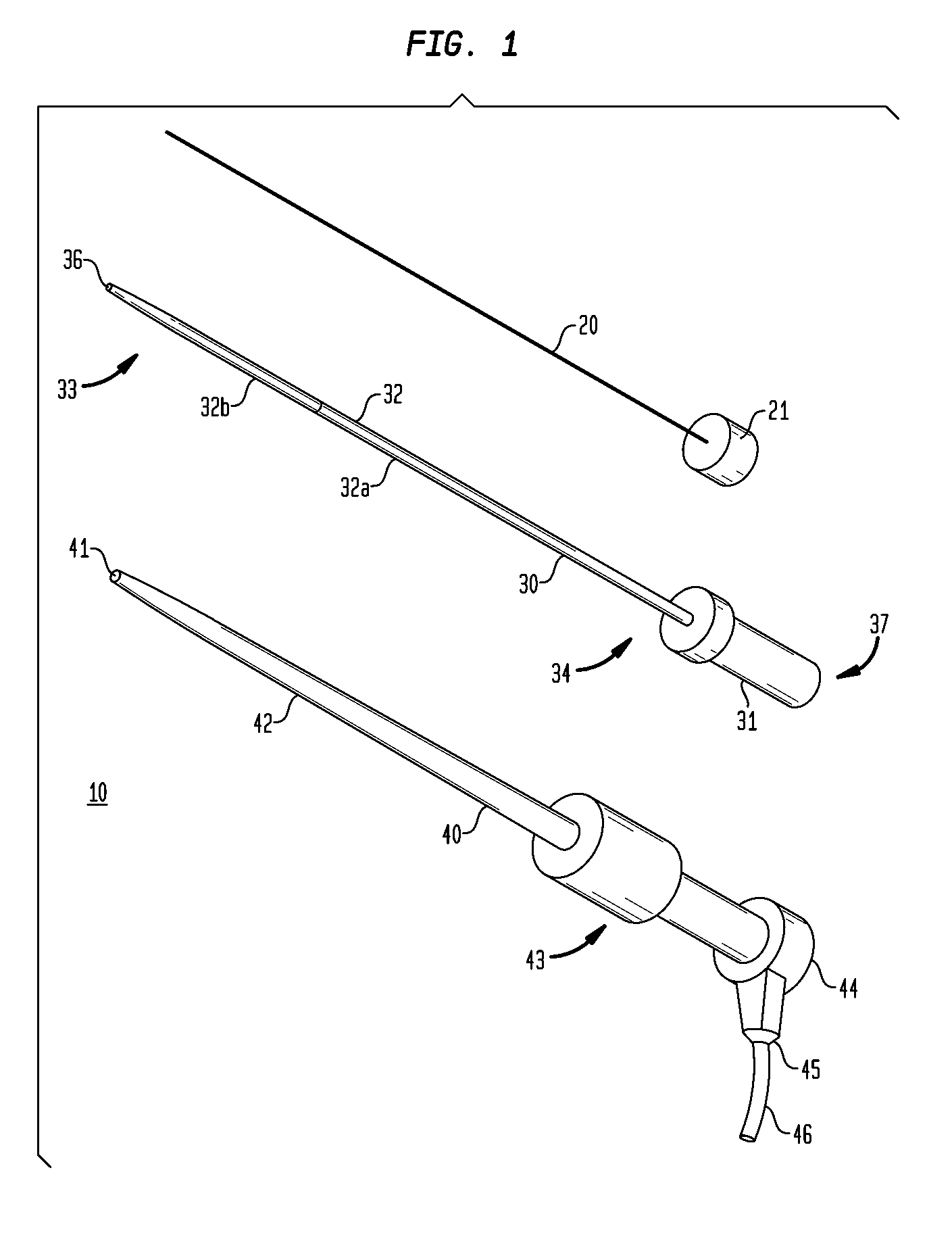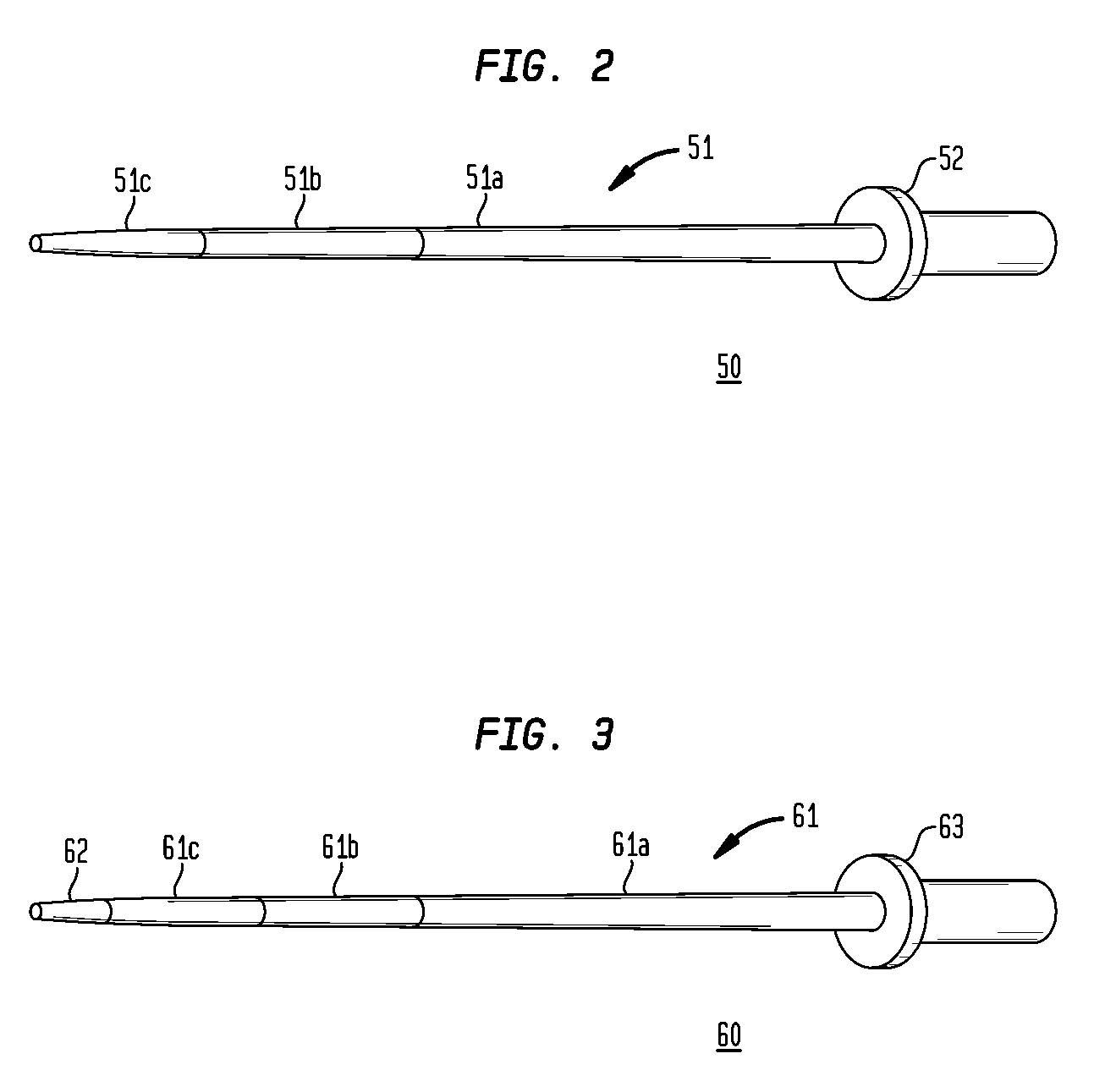Guide Sheath Dilator And Method Of Using The Same
a technology of dilators and guides, which is applied in the field of selective guide sheath dilators, to achieve the effect of reducing the trauma caused by access and facilitating movement through the vasculatur
- Summary
- Abstract
- Description
- Claims
- Application Information
AI Technical Summary
Benefits of technology
Problems solved by technology
Method used
Image
Examples
first embodiment
[0034]In addition, as can be seen from FIG. 1, the dilator device 30 of the present invention offers multiple stiffness sections 32a-b. That is, the dilator device 30 includes a shaft 32 that has a distal end 33, a proximal end 34 and two stiffness sections 32a-b. These stiffness sections 32a-b become less rigid as they approach the distal end 33. In other words, the shaft is the softest at the distal end (approximately 30 shore D to 70 shore D) and transitions to the stiffest section at the proximal end (approximately 50 shore D to 80 shore D). The varying stiffness sections 32a-b allow the dilator device 30 to slightly bend around twisted and bent vasculature, so as the dilator 32 is advanced and the stiffness is changed, the bent vasculature is straightened. The varying stiffness sections also provide for greater pushability when advancing through the vasculature.
[0035]The dilator 32 may also taper along the length the dilator 33. That is, the dilator may taper along the full len...
second embodiment
[0042]In a second embodiment, as shown in FIG. 2, the shaft 51 may have three stiffness sections 51a-c. The first stiffness section 51a may be approximately 25-90 cm in length with a durometer of approximately 50 shore D to 80 shore D, the second stiffness section 51b may be approximately 1-70 cm in length with a durometer of approximately 30 shore D to 70 shore D and the third stiffness section 51c may be approximately 1-70 cm in length with a durometer of approximately 40 shore A to 40 shore D.
[0043]The material blends of these stiffness sections also vary significantly depending on application and length of the dilator. The stiffness sections 51a-c can also be made from a blend of between 0-95% PP impact copolymer and between 5-100% high performance elastomer (TPV). In a preferred embodiment, the first stiffness section 51a may be made from an approximate blend of 50% high performance elastomer (TPV) and 50% PP impact copolymer containing approximately 30% Bi2SO4, the second stif...
third embodiment
[0044]In a third embodiment, as shown in FIG. 3, a tip 62 can be connected to the distal end of the shaft 61. The tip would be the softest and least rigid section of the shaft 61 resulting in an atraumatic tip 62. In this embodiment, the tip is attached to a dilator 60 having three stiffness sections 61a-c. But the tip may be used in conjunction with a shaft having any number of stiffness sections including a shaft that has a substantially even gradient of stiffness.
[0045]The dilators 30, 50 and 60 are all used in conjunction with the sheath device 40. These dilators 30, 50 and 60 are coaxially disposed within a lumen 41 of the sheath device 40. The sheath 40 is approximately 90 cm long when used with a femoral access point but longer (approximately 120 cm) and shorter (approximately 30 cm) sheaths and dilators may be used when accessing a vessel.
[0046]The sheath device 40 includes an elongated tubular sheath 42, a hub 43 and a valve 44. The sheath 42 can be secured to the hub 43 by...
PUM
 Login to View More
Login to View More Abstract
Description
Claims
Application Information
 Login to View More
Login to View More - R&D
- Intellectual Property
- Life Sciences
- Materials
- Tech Scout
- Unparalleled Data Quality
- Higher Quality Content
- 60% Fewer Hallucinations
Browse by: Latest US Patents, China's latest patents, Technical Efficacy Thesaurus, Application Domain, Technology Topic, Popular Technical Reports.
© 2025 PatSnap. All rights reserved.Legal|Privacy policy|Modern Slavery Act Transparency Statement|Sitemap|About US| Contact US: help@patsnap.com



